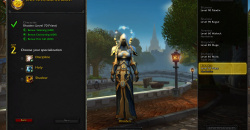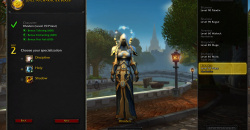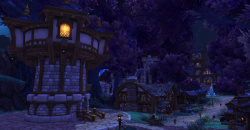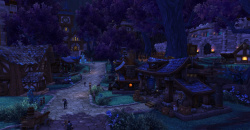Blizzard released Diablo III for PC in 2012 and followed up with versions for PlayStation 3 and Xbox 360 in 2013. Since August 19 of this year, owners of next-gen consoles can also join the adventure. But if you think they’ve just released a bland port of the PC version, you’re wrong. Diablo III: Ultimate Evil Edition is not just another version of the 2012 PC game, but rather an enhanced edition that includes the 2014 Reaper of Souls expansion pack with its 15 additional hours of storyline as well as at least 7 more hours of gameplay action. Read the test review to find out whether this is enough to justify buying Diablo III for the Xbox One or the PlayStation 4.
Storyline
The storyline in Reaper of Souls picks up right where the main game leaves off. After Diablo is destroyed, his remains are imprisoned within the Black Soulstone, an artifact so powerful that not even the Lord of Darkness himself is able to break free from its bonds. But what was thought would finally bring humanity its long-awaited peace ends up bringing about the greatest threat to its survival yet. Tyrael himself embarks on the journey to bring the Stone to a secure place where the Powers of Darkness should never be able to find it. But Malthael answers his master’s call and arrives on the scene. The erstwhile Angel of Wisdom, now an ally of the dark side, mercilessly crushes humanity’s last valiant efforts at resistance and the Black Soulstone is broken in the violence that ensues. From this moment on, a swath of destruction spreads throughout the entire land, and no one dares deny that the ultimate annihilation of humanity is but a matter of time. Cities utterly devastated and streets devoid of life all seem to point to a future devoured by darkness, but is there in fact a chance we will once again be able to overcome it and survive?
Gameplay
In its time, Diablo more or less single-handedly reinvented the Action RPG genre. Thousands of players back then were captivated by the combination of an intuitive gameplay mechanic, as easy to learn as it was difficult to master, with a pressing and ever-present urge to acquire better equipment and to level up. So it’s no surprise that more than 15 years after the release of the first game, Blizzard decided to stick with the same tried-and-true gameplay mechanic for the latest title in the series. While technically 3D, the camera perspective still has the same feel as the isometric POV used in Diablo and Diablo II, and just like in the older games, players fight through dungeon after dungeon filled to the brim with monsters and other unholy creatures until they can finally stand face-to-face with Diablo himself. Anyone who reaches this point will have already spent many, many hours in the world of Diablo.
All for one and one for all
It’s up to you to decide which of the five chosen heroes you will begin your campaign against the forces of evil with. Would you rather have the undead fight for you as the Witch Doctor, call down lightning bolts as the Wizard, or use your bare hands to dispatch your enemies as the Monk? Or will it be the axes and swords of the Barbarian or the Crusader that will have the enemy hordes trembling? Not only does each class offer a wide variety of unique features; the basic gameplay style for each one is entirely different as well. Are you going to fight from a safe distance and remain in the background, or would you rather jump right in and fight man-to-man? The choice is yours.
A world on the brink
The main storyline unfolds across the game’s five Acts via gameplay action, in-game sequences, rendered cut-scenes, audio logs, and conversations with NPCs. All of these methods taken together combine to take players and immerse them step-by-step into the universe of the Diablo series. Unexpected plot twists help to move the plot forward, and at least the first time you play through it, provide a somewhat welcome diversion from the daunting task of exploring the game world.
One time you find yourself in the middle of an invasion helping to defend the walls from swarms of encroaching enemies; another time you’re fighting your way through endless deserts and desert temples; near the end you set off on an expedition to Heaven itself. Variety is the name of the game here, and Diablo III never ceases to provide it. Even the linear, pipe-like segments are well designed and regularly alternate with more open environments that encourage free exploration. If you keep your eyes open in these areas, you’re sure to find the countless optional caves and catacombs that are strewn throughout the game. Explorers can expect to be rewarded in the form of items, gold, or even additional quest-givers.
Of course, at the beginning of your adventure there’s no question of going up against Diablo in direct combat. All you have at your disposal is a crappy weapon and a few paltry skills, so you start off by looking around town and helping out the townsfolk. You always run across people in the various settlements, and even lone individuals out in the game world, who are eager to provide you with odd jobs not necessarily related to the main plot.
By completing these side quests, most of which have to do with finding objects or thinning out the ranks of the enemy, you’ll get your first experience points and pieces of equipment. A colored label lets you know right away whether it’s even worth picking up an object or not. While you’ll probably grab everything you can find at the beginning of your journey, after a few hours you’ll limit yourself to magic, rare, set, or legendary items, since this usually offer additional perks like elemental damage or skill bonuses. Red or green arrows indicate whether an item is better than the item you currently have equipped or not. You can “fast equip” an item in the middle of the action by pressing a button, and avoid interrupting the flow of game, but if you want to see more detailed information, such as exactly how much damage a weapon deals, you’ll have to open up the inventory and check it out there. This is one place where Blizzard didn’t fail to take the needs of console players into account, choosing to put in a ring menu to cycle through items. While not as straightforward as the interface in the PC version, it’s specifically designed to fit the layout and playing style associated with a controller. The system is relatively easy to navigate, and once you get used to it, it’s a really convenient way to manage items.
Unfortunately, the hero has a limited carrying capacity, which means you’ll have to regularly clean out your inventory, preferably for cash. And if you want to treat yourself, you can use the gold you earn to buy new equipment from one of the various merchants you come across. Later in the game you can also visit the village blacksmith. If you invest enough gold and materials, he’ll gain experience, further improving his skills and the quality of his craftsmanship. As the game progresses, the blacksmith becomes more and more important. He can repair weapons and armor, but more importantly, he can forge new items and break down unwanted magic items to salvage basic and magic materials, which can be used to make new items.
There are a lot of possibilities when you’re building your character, but make sure you don’t lose sight of your attributes. You gain experience with each enemy you defeat, and it doesn’t take long to level up.
And they went forth to learn how to fight
At the beginning of the adventure, the learning curve is not all that steep, and even groups of monsters shouldn’t be too much of a problem. But if you want to be able to survive in the later stages of the game, you’re going to have to improve your skills and attributes wisely. Apart from equipment, you can also customize your character according to your own needs as your prepare to complete the various tasks you’ll be assigned. There are at least 22 active and 22 passive skills as your disposal, most of which can be modified with “skill runes” that enhance your skills in various ways, such as by increasing effects or by adding new ones. New skills are automatically unlocked when the character levels up, and while this is really convenient for players new to the game, it also takes away the possibility of settling on a playing style from the beginning. All too often, you’re forced to wait for your character to level up several times before you can unlock a new and more powerful version of your favorite skill. And since Diablo’s minions are constantly getting more and more powerful through the course of your journey, there are going to be times where you’ll have to switch to a different strategy for the time being.
You unlock your last skill when you reach Level 70, which is also the new upper limit that was introduced with the Reaper of Souls expansion. But there’s no way you’re going to reach this level with just one play-through. And this is where the title’s long-term motivation lies: you can start a new game with your hero, this time at a higher difficulty level (unlocked when you beat the game on the previous one). Each difficulty level features better items and bonuses to the gold and experience you receive from killing enemies. Your character’s personal storage chest is also available from the previous play-through whenever you replay the game a higher difficulty level, which means you can use any of the items you stored in there any time you enter a town. And this doesn’t just go for your current character, but for any character on your account. This saves long, boring hours of searching for items you’ve already found, and helps you get started faster with each new hero.
Well-equipped and ready for battle, you can go right up against the enemy hordes and start cracking skulls. And the combat gameplay is really dynamic – the left analog stick controls your hero’s movements, and the four action buttons and the trigger buttons are for your special attacks, which you can configure for each individual character. The right analog stick is used to dodge attacks by rolling out of the way. If you do end up taking damage, though, there are not only the classic healing potions, but also health orbs, which are dropped by slain enemies. While these orbs replenish only a fraction of your health, you can pick up a lot of them in the course of battle, and they work automatically. White power orbs work the same way, though they’re not as common. These give you a temporary damage bonus.
Every now and then you’ll get the chance to see whether your combination of skills and armor is really up to snuff when you go up against boss enemies. In every dungeon, there’s usually a mid-boss and a final boss lurking about somewhere. Final bosses can often be big enough to fill the screen, and they can dish it out as well as they can take it. Each exciting boss battle requires you to recognize the boss’s unique attack pattern and to launch your counterattacks at just the right time. The slightest tactical error will cause you to lose health, and combined with traps, obstacles, and smaller enemies swarming all around you, these minutes-long duels can end up really testing your nerves. Don’t be surprised to see your hero die a gruesome death every now and then, which causes some damage to your equipment’s durability. However, you now have the option of reviving right near your corpse, so you can get right back in the action.
If you ever have trouble forging ahead alone, you can also get NPC “followers” to fight for you. Over the course of the game, you’ll meet a Scoundrel, an Enchantress, and a Templar, who will assist you in battle if you want them to. You can choose one of them to help you in your search for Diablo, and they can even level up and learn new skills, even if only in a limited way. Unfortunately, your ally will for the most part be a lot weaker than you are, so they’ll tend to function as not much more than a punching bag to draw attacks away from you. The only real help you’re going to get is in multiplayer mode.
Multiplayer
If you’re looking for a little bit of human support, you can play multiplayer – either online or in split-screen mode. Playing with up to three other players really makes the struggle against the forces of hell a good bit more fun. The drop-in/drop-out system allows you to join a party in the middle of the game or leave whenever it’s convenient – just indicate whether you want to play the campaign or Adventure mode. You’re also able to decide whether you want to play a game corresponding to your current campaign progress or whether you want to play a particular Act. Exclusive to the console version of the game is Apprentice Mode, where you can join parties even when your character doesn’t meet the level requirements. You join as an “Apprentice”, and are “taken along” by the other players. This speeds up the time it takes to level up, and also gives you a chance to pick up valuable items. This is great for casual gamers who just want to go online and play with their friends for a little bit, even if their friends’ characters are a lot more powerful. You can also make your campaign “open”, and wait for players from all over the world to join up with you.
Graphics & Sound
The PC and the PS4 versions are about as similar as they can be in terms of graphics, with both more or less on the same level. While the graphics in neither version are really better, it’s hard to imagine the next-gen consoles are being used to their full capacity, either. Levels are beautifully designed and there’s a wide variety of highly-detailed enemy models, but it’s clear after the first few seconds in New Tristam that barely anything has been done to the graphics. This is one place where you could have expected them to improve things a little, given the two years of development time they had between the PC and the next-gen console release of the game. While the developers claim they redid the lighting effects, any noticeable trace of this is marginal, at best. In contrast to the Xbox 360 and PlayStation 3 versions, however, Xbox One and PlayStation 4 owners can enjoy the game in 1080p resolution. Even with 4 players, there’s no noticeable negative effects on frame rate.
As for the soundtrack and sound effects, there’s really nothing to improve anyway. Musical pieces always fit what’s going on in the game, providing the right amount of depth for each situation. All dialogue in Diablo III: Ultimate Evil Edition is voice-recorded, and the actors do a good job. Unfortunately, you can’t stop most of the NPCs from talking, and their largely unnecessary dialogue can get pretty annoying.
Hey, I’ve been here before…
If you already own a copy of Diablo III for the PC or one of the console versions, you can continue your adventure where you left off there. All you have to do is enter you registration data and you can transfer your hero to the new platform, all at not extra charge. Unfortunately, other characters that aren’t saved on the account you’re importing will be lost, so it’s best to do this before you start any new campaigns.


















cool
i love this game